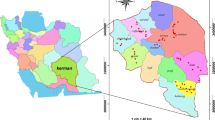Abstract
Wind erosion force vectors were computed from data of frequencyof occurrence of windspeed and direction based on the assumptionthat wind erosion is proportional to (windspeed)3× duration of exposure.The vertical distribution of eroded soil material wasmathematically described. The transition height betweensaltation and suspension could be identified and used tointegrate the two equations describing saltation and suspension.The soil avalanching process was studied by evaluating the horizontal changes of eroded soil material. The vertical andhorizontal distribution of eroded soil constituents, i.e.,particle size distribution, mean weight diameters, plantnutrients and heavy minerals content for selected wind stormswere also evaluated. Results revealed that soil constituents change considerably with the height and downwind distance.To assess the changes in soil properties due to wind erosion,surface soil samples were taken from the original eroded surfaceand from freshly accumulated drifts near the eroded field.Enrichment ratios were more than one for the fine fraction, organic matter, moisture retention, and chemical constituentsindicating a loss in their contents in the eroded field.
Similar content being viewed by others
References
Bagnold, R. A.: 1943, The Physics of Blown Sand and Desert Dunes, Methuen, London.
Black, C. A.: 1965, Methods of Soil Analysis, Amer. Soc. of Agron., Agronomy Series No. 9, Wisconsin, U.S.A.
Chepil, W. S., Siddoway, F. H. and Armbrust, D. V.: 1964, ‘Prevailing Wind Erosion Direction’, J. Soil and Water Cons. 19, 67–70.
Chepil, W. S.: 1945, ‘Dynamics of wind erosion: III The transport capacity of the wind’, Soil Sci. 60(6), 475–480.
Fryberger, S. G.: 1979, ‘Dune Forms and Wind Regime’, in E. D. McKee (ed.), A Study of Global Sand Seas, U.S. Government Printing Office, Washington D.C., pp. 137–169.
Fryrear, D. W.: 1986, ‘A field dust sampler’, J. Soil and Water Cons. 41(2), 117–120.
Fryrear, D. W., Stout, J. E., Hagen, L. J. and Vorics, E. D.: 1991, ‘Wind erosion field measurement and analysis’, Trans. ASAE 34, 155–160.
Hagen, L. J.: 1991, ‘A wind erosion prediction system to meet user needs’, J. Soil and Water Cons. 46, 106–111.
Katsoulis, B. D. and Metaxas, D. A.: 1992, ‘The wind energy potential of western Greece’, Solar Energy 49(6), 463–476.
Singg, A. W.: 1953, ‘Wind tunnel studies of the movement of sedimentary material’, 5th Hydraul. Conf. Proc., Iowa Inst. Hydraul. Bull 34, pp. 111–135.
Skidmore, E. L.: 1965, ‘Assessing wind erosion: Directions and relative magnitudes’, Soil Sci. Soc. Am. Proc. 29, 587–590.
Skidmore, E. L.: 1987, ‘Wind erosion direction factors as influenced by field shape and wind proponderance’, Soil Sci. Soc. Am. J. 51, 198–202.
Skidmore, E. L. and Woodruff, N. P.: 1968, Wind Erosion Forces in the United States and their use in Predicting Soil Loss, Agriculture Handbook No. 346, USDA-ARS Kansas Agric. Exp. Sta.
Vandevelde, R., DeBoodt, M. and Gabrile, D.: 1974, Determination of an Erosion Index for Conditioned Soils in Accordance with Data of the Rainfall Simulation, Pedologic XXIV(1), Ghent, Belgium, pp. 5–16.
Woodruff, N. P. and Siddoway, F. H.: 1965, ‘A wind erosion equation’, Soil Sci. Soc. Amer, Proc. 29(5), 602–608.
Author information
Authors and Affiliations
Rights and permissions
About this article
Cite this article
Moursy, F.I., Gaber, E.I. & Samak, M. Sand Drift Potential in El-Khanka Area, Egypt. Water, Air, & Soil Pollution 136, 225–242 (2002). https://doi.org/10.1023/A:1015233507882
Issue Date:
DOI: https://doi.org/10.1023/A:1015233507882



